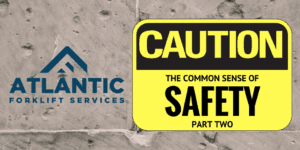Last time we discussed how to operate your forklift safely, before you start the ignition.
This time, we get to manage a load and move it from one place to another, with safety in mind.
We’ve walked around the lift, we’ve dressed appropriately, climbed on board safely and checked the controls.
Ok, turn that key- we’ve got work to do- but before you move, consider your surroundings. Any people around? Obstacles that need to be moved, or ones that can’t be moved and need to be avoided?
Anything along the way that’s too low for your mast?
Are you operating on a loading dock? Be aware of the edge. Observe warning signs and only drive the lift on your facility’s designated roadways- and of course, only operate the forklift at a safe speed, being constantly aware of what’s around you.
Use your horn when you’re approaching corners or blind spots and even when you are about to back up.
Ok, approach that load- but before you do- take stock not only of how you might pick it up, but how you’re going to deliver it. Picking it up one way may not leave you in the right position to drop it off.
Once you have picked up the load, make sure it’s stable and secure. The load should be tilted back a little bit, and your forks should be low while you’re moving the load. This ensures maximum stability.
NEVER lift a load that seems unstable.
Check for overhead obstacles.
Sometimes a load can obstruct your vision. It’s ok to operate the lift in reverse EXCEPT when you’re moving up a ramp. Do not hesitate to get someone to spot for you if you need. Again, don’t be a hero.
This is squarely in the “common sense” category, but remember forklifts are for loads only. Don’t carry people on your forks. Just don’t.
Watch for people moving under the load. This can be very dangerous if the load is unstable.
After your shift, park the lift in its designated location. Lower the forks to the floor and apply the brakes. Remove the key and return it to its home. Of course, NEVER leave the forklift running unattended.
Accidents happen, but if you follow all these steps, plus a few we didn’t have space for here, you can greatly reduce the chance of an accident happening.
For more, check with your Atlantic Forklift Services rep for more about how to operate your forklift safely, training and even insurance. We can walk you through all of it.
In the meantime, here is the link to OSHA’s Forklift Safety site. https://www.osha.gov/SLTC/poweredindustrialtrucks/.

